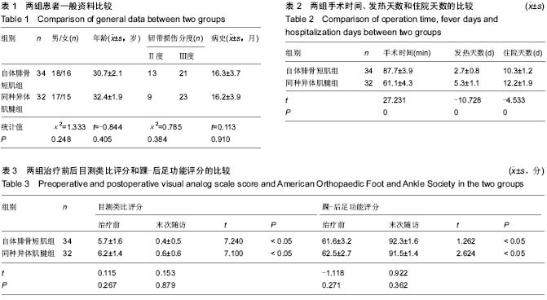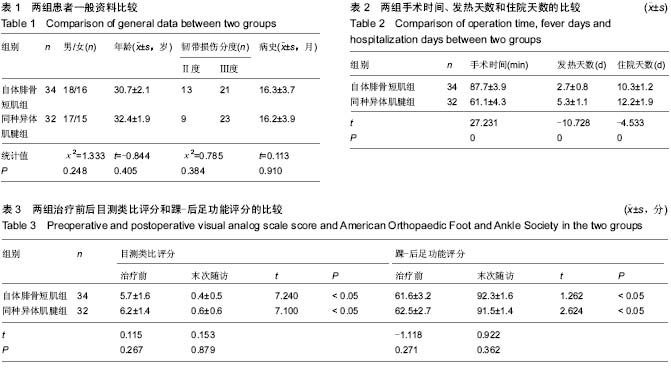| [1] Grass R,Herzmann K,Biewener A,et al.Injuries of the inferior tibiofibular syndesmosis.Unfallchirurg. 2010;103(7): 520-532.
[2] Bach Jr,Bernard R,Aadalen Kirk J,et al.Primary Anterior Cruciate Ligament Reconstruction Using Fresh-Frozen Nonirradiated Patellar TendonAllograft.Am J Sports Med. 2011;33(2):284-292.
[3] Gene B,David S,Miranda W.Anterior Cruciate Ligament Reconstruction in Patients Older Than 40 Years: Allograft Versus Autograft Patellar Tendon.Am J Sports Med.2012; 33(10):1505-1512.
[4] Carrera MR, Meijler MM, Janda KD.Cocaine pharmacology and current pharmacotherapies for its abuse.Bioorg Med Chem.2004;12(19):5019-5030.
[5] 曹飞,徐顺利,王世海.早期手术重建治疗踝关节外侧不稳定的疗效分析[J].中国骨与关节损伤杂志,2010,24(2):169-170.
[6] Rubenstein LZ, Josephson KR,Trueblood PR,et al.Effects of a group exercise program on strengh, mobility,and falls among fall-prone elderly men.J Gerontol A Biol Sci Med Sci.2010; 55(6):317-321.
[7] Samoto N,Sugimoto K,Takaoka T,et al.Comparative results of conservative treatment for isolated anterior talofibular ligament (ATFL)injury and injury to both the ATFL and calcaneofi bular ligament of the ankle as assessed by subtalar arthrography.J Orthop Sci.2007;12(1):49-54.
[8] Zwipp H,Rammelt S,Grass R.Ligamentous injuries about the ankle and subtalar joints.Clin Pediatr Med Surg.2012; 19(2): 195-229.
[9] Hinterman B,Boss A,Schafer D.Arthropic findings in patients with chronic,ankle instability. Am J Sports Med. 2012;30(3): 402-409.
[10] Strauss JE,Forsberg JA,Lippert FG 3rd.Chronic Lateral ankle instability and associated conditions:a ration for treatment.Foot Ankle Int.2011;28(10):1041-1044.
[11] Courvoisier A,Vialle R,Thévenin-Lemoine C,et al.The posterior talofibular ligament: an anatomical study with clinical implication in clubfoot surgery.Surg Radiol Anat. 2008;30(8): 633-637.
[12] Lawhom KW,Howell SM. Scientific justication and technique for anterior cruciate ligament reconstyuction using autogenous and allogeneic soft-tissue grafts.Onhop Clin North Am.2013;34:19-30.
[13] Duc SR,Mengiardi B,Pfirrmann CW,et al.Improved visualization of collateral ligaments of the ankle:multiplanar reconstructions based on standard 2D turbo spin-echo MR images.Eur Radiol.2010;17:1162-1171.
[14] Cuban AR,Adams DJ,Gill JL,et al.The biomechanical effects of low-dose irradiation on bone-patellar tendon-bone allografts.Am J Sports Med.2010;32: 1131-1135.
[15] Fideler BM,Vangsness CT Jr,Lu B,et al.Gamma irradiation: effects on biomechanical properties of human bone-patellar tendon-bone allografts.Am J Sports Med. 1995; 23:643- 646.
[16] Schwanz HE,Matava MJ,Proch FS,et al.The effect of gamma irradiation Oil anterior cruciate ligament allograft biomechanical and biochemical properties in the caprine model at time zero and at 6 months after surgery.Am J Sports Med.2012;34:1747-1755.
[17] Grieb TA,Fomg RY,Bogdansky S,et al.Highdose gamma irradiation for soft tissue allografts:High margin of safety with biomechanical integrity.J Orthop Res.2012;24:1011-1018.
[18] Grewal R,MacDermid JC,King GJW,et al.Open reduction internal fixation versus percutaneous pinning with external fixation of distal radius fractures a prospective randomized clinical trial.J and Surg Am.2011;36(12):1899-1906.
[19] Barbour SA,King W.The safe and effective use of non graft tissue an update.Am J Sports Med.2003;31(5):791-797.
[20] Klitscher D,Mehling I,Nowak L,et al.Biomechanical comparison of dorsal nail plate versus screw and K-wire construct for extra-articular distal radius fractures in a cadaver bone model.J and Surg Am.2010;35(4):611-618.
[21] Kraeutler MJ,Bravman Jr,MeCarty EC.Bone patellar tendon bone auto graft versus allograft in outcomes of anterior cruciate ligament reconstruction:a meta-analysis of 5182 patients.Am J Sports Med.2013;41(10):2439-2448.
[22] Hu J,Qu J,Xu D,et al.Auto graft versus auto graft for anterior cruciate ligament reconstruction:an up to date meta analysis of prospective studies.Int Orthop.2013; 37(2):31 1-320.
[23] Hudgens JL,Gillette BP,Kryeh AJ,et al.Autograft versus in posterior ligament reconstruction:an evidence based systematic view.J Knee Surg.2013;26(2):109-115.
[24] Ferran NA,Oliva F.Ankle instability.Sports Med Arth.2009; 17:139-145.
[25] Maffulli N,Ferran NA.Management of acute and chronic ankle instability.J Am Acad Orthop Surg.2008;16:608-615.
[26] 徐琦,宋涛.改良Brostrom技术治疗慢性踝关节外侧不稳[J].中国矫形外科杂志,2010,21(18):482.
[27] Lin CW,Hiller CE,De Bie RA.Evidence based treatment for ankle injuries:a clinical perspective.J Man Manip Ther. 2010; 18:22-28.
[28] 张学忠,王伟,张振宇.应用半腱肌腱重建外侧副韧带治疗慢性踝关节外侧不稳定[J].中国医药指南,2010,8(35):275-276.
[29] Takao M,Oae K,Uchio Y,et al.Anatomiacal reconstruction of the lateral ligaments of the ankle with a gracilis autograft :a new technique using an interference fit anchoring system.Am J Sports Med.2005;33:814-823.
[30] Bauer JS,Barr C,Henning TD,et al.Magnetic resonance imaging of the ankle at 3.0 Tesla and 1.5 Tesla in human cadaver specimens with artificially created lesions of cartilage and ligaments.Invest Radiol.2008;43(9):604-611.
[31] Hua J,Xu JR,Gu HY,et al.Comparative study of the anatomy, CT and MR images of the lateral collateral ligaments of the ankle joint.Surg Radiol Anat.2008;30(4):361-367.
[32] O'Neill PJ,Van Aman SE,Guyton GP.Is MRI adequate to detect lesions in patients with ankle instability.Clin Orthop Relat Res.2010;468(4):1115-1119.
[33] Morelli F,Perugia D,Vadalà A,et al.Modified Watson-Jones techni Gue for chronic lateral ankle instability in athletes clinical and radiological mid-to long-term follow-up.Foot and Ankle Surgery.2011,17:247-251.
[34] Margaliot Z,Haase SC,Kotsis SV,et al.A Meta-analysis of outcomes of external fixation versus plate osteosynthesis for unstable distal radius fractures.J Hand Surg Am.2005;30(6): 1185-1199.
[35] 杨宜,舒世琼,鲍同柱,等.外侧副韧带重建结合关节镜下治疗慢性踝关节外侧不稳体会[J].骨科,2012,9(39):193-199.
[36] 黄东红,王平,卢启贵,等.同种异体肌腱修复重建治疗踝关节外侧副韧带损伤[J].中国骨与关节损伤杂志,2011,26(10):953-955
[37] 王培,闫洪伟,李哲,等.踝关节外侧副韧带损伤17例:锚钉与同种异体肌腱修补重建[J].中国组织工程研究与临床康复,2010, 14(9):1621-1624.
[38] 胡牧,徐向阳,刘津浩,等.自体与异体肌腱微创重建踝关节外侧韧带的临床对比研究[J].中华骨科杂志,2014,34(4):448-453.
[39] Henry M.Distal radius fractures current concepts.J and Surg Am.2008;33(7):215-227.
[40] Knox J,Ambrose H,McCallister W,et al.Percutaneous pins versus volar plates for unstable distal radius fractures a biomechanic study using a cadaver model.J Surg Am.2007; 32(6):813-817.
|



